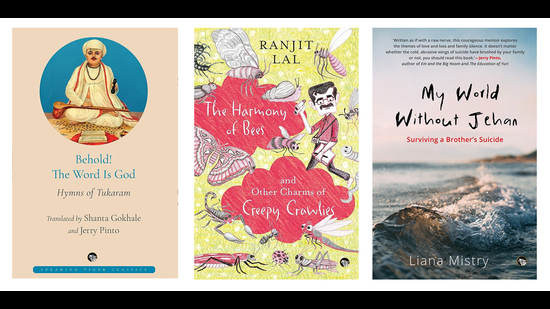HT Picks; New Reads
This week’s reading list includes a book that captures the mystic wisdom of Tukaram’s hymns, another that looks at diminutive crawling creatures, and a memoir that confronts the silence around a sibling’s suicide
Says Tuka


Behold! The Word is God contains a selection of 51 abhangas (devotional poems) from celebrated Bhakti poet Tukaram’s vast oeuvre, each Marathi abhanga followed by two English interpretations — Shanta Gokhale’s and Jerry Pinto’s. Hailed as one of the greatest poets in the Marathi language, Tukaram composed poems that are packed with hidden layers of meaning. So, two independent translations of each abhanga give readers a chance to gain a deeper understanding of the original. The saint-poet’s original abhangas are included in the book alongside the translations as Roman transliterations.
Tukaram’s abhangas, copied by many hands and gathered over several years, do not follow any particular order. But the translators, keen to give their selection a narrative order that would offer readers a view of the abhangas beyond their immediate sense, have arranged them into three groups — Tukaram and poetry, Tukaram and life and Tukaram and Vitthala.
Pinto does what Arun Kolatkar and Dilip Chitre had done in their translations of Tukaram — recast the abhangas as independent poems that run parallel to Tukaram’s creations. Gokhale, on the other hand, stays as close as possible to the sense, movement, rhythm and form of the originals. Together, their translations capture the mystic wisdom and the musicality of Tukaram’s hymns, and open a whole world of meaning for today’s readers.*
All things weird and wonderful

They have lived on Planet Earth from well before the first apes and humans appeared. They lead fascinating lives that involve shooting, stinging, flying, jumping, biting, and more. Some can lift 500 times their body weight. Some others navigate their way using the stars or even the Milky Way. Some are deadly carriers of disease. And some pollinate more than one-third of our food sources. Together, they are essential for life on Earth to continue in an even balance. They are: ants, beetles, scorpions, mantids, butterflies, bees, spiders, cockroaches and yes, even mosquitoes and flies!
No one can describe the natural world as delightfully and humorously as Ranjit Lal, and in The Harmony of Bees he brings his decades of experience watching and closely interacting with the world of creepy crawlies to writing about more than twenty kinds of them. Termites have central air conditioning in their nests, he tells us. A grasshopper can jump 10 times its own height (which is like us jumping the length of a football field in one leap). The tiny fig wasp is key to the survival of the mighty banyan tree. Not everyone hates cockroaches — a zoo in Japan organized a cockroach exhibition and ‘cockroach petting sessions’! Along with these bizarre and wonderful facts, Ranjit Lal explains how these creatures live, mate, build their homes and look after (or eat) their young.
Sometimes creepy, sometimes gruesome, always entertaining and packed with information, this is an immensely entertaining and unusual nature book.*
On healing and letting go

Relocating every few years, not always together, the Chinoys were far from a typical household. For all that, they were a happy family, until they could no longer pretend to be, when, in September 1986, they lost Jehan, the most tender and passionate of the five of them.
Many years later, the kid sister, Liana, tries to fill the gaping hole left by her brother, the loving though tempestuous young man who took his life at 22. She was 14 at the time. All she has of him now are her memories, fading at the edges, like the handful of old photographs she has of him. She can recall the flamboyant and popular boy at school, but also the one at home, manic depressive, and struggling to come to terms with his sexuality. Her family chose never to speak about the suicide — particularly to their youngest member — instead burying the pain they must have felt. Were they as ridden with guilt as she was, and is, for not being able to prevent Jehan’s death? Were they ashamed that he was not like other boys his age, that he was different? She doesn’t know. She lives her life grieving privately, imagining they’re doing the same.
My World Without Jehan is Liana’s cathartic attempt to confront this decades-long silence. Her shattering yet hauntingly beautiful tribute to her beloved brother is ultimately a memoir about forging a path to healing and understanding, and, finally, to letting go.*
*All copy from book flap.






